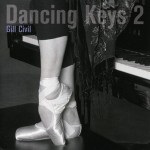by Laura Donnelly
 I recently received a copy of Gill Civil’s Dancing Keys 2 CD and highly recommend it to dance teachers looking for good recorded music for dance class. While the music is written primarily for the ballet class, I feel a number of the selections would also work well for modern dance classes.
I recently received a copy of Gill Civil’s Dancing Keys 2 CD and highly recommend it to dance teachers looking for good recorded music for dance class. While the music is written primarily for the ballet class, I feel a number of the selections would also work well for modern dance classes.
The CD contains 37 tracks of original music composed for ballet class. The melodies are beautiful. I found them inspiring and could easily think up several good combinations for each track. The music is clear so that subdivisions in the beat are easy to hear. This gives me more flexibility in how to use the music for different combinations and class levels.
There is good variation from track to track. The pieces sound different from each other in both melody and texture. Civil uses a variety of different tempi which I find very helpful when planning classes.
In the album notes Civil lists a suggested dance exercise, the title of the piece, number of bars, tempo, and length of the track. For me, when working with CDs tempo, number of bars, and length of piece are crucial. I like to select longer tracks for continuous across the floor combinations or adagios and I like to choreograph my exercises so that they fit the musical phrasing of the selected track. This information provided allows me to do this easily.
I am delighted with Civil’s Dancing Keys 2 and will use it often in my classes. She has a good feel for the type and variety of music that makes an interesting and inspiring dance class. I’ll purchase her original Dancing Keys CD and eagerly await the release of Dancing Keys 3. For more information about Gill Civil and to purchase her CDs visit http://www.pianomusicforballet.com
Laura Donnelly, MFA, BA is a choreographer, teacher, and dancer who also writes and creates community based public art projects involving visual and word art. Beginning August 2012, Laura will be Assistant Professor of Dance at Kansas State University. Her research interests include pedagogy, oral tradition in dance, collaborative process, music for dance, and the Alexander Technique. Her research has been presented at the Congress on Research in Dance, the International Association of Dance Science and Medicine, the National Dance Education Association, the Hawaii International Conference on Arts & Humanities, the 5th Annual International Conference on Civic Education, and the 2011 University of New Mexico Mentoring Conference. Laura’s essay Meditation in the Dance Studio is published in Teaching with Joy: Educational Practices for the Twenty-First Century, Rowman & Littlefield Publishers.




